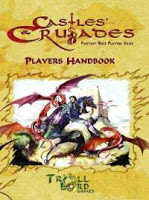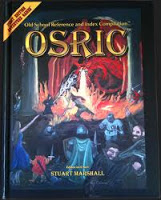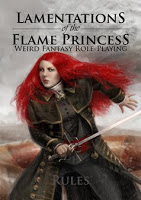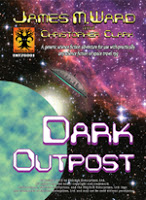There is, of course, no singular event that one can point to and say, “The OSR started here.” Certainly it was a product of a particular time within the gaming hobby, wherein a number of circumstances combined to make the OSR possible. D&D 3.5 was petering out and 4th edition was received to blasé reviews or outright hostility. The OGL allowed games such as Castles & Crusades (2004) and OSRIC (2006), and later Labyrinth Lord, Swords & Wizardry, MicroliteXX, etc. to come about, and desktop publishing and the increasingly sophisticated abilities of on-demand publishing made it possible for individuals or a handful of people to put out really incredible products for little or no cash up front.
2008 was the year many flagship OSR blogs were founded, such as the Retroroleplaying Blog (founded February 20008); Grognardia (March 2008); The Society of Pole, Torch, and Rope (August 2008); and Bat in the Attic (October 2008); among many, many others too numerous to name. These blogs and message boards such as Dragonsfoot and the Knights and Knaves Alehouse (again, plus many others) fostered a community of deep introspection, analysis, and discussion about just what made older games great, on a mechanical, “player ethos”, and aesthetic level.
However, one thing I’ve noticed in the last year or so is that the level of philosophical analysis has decreased dramatically both on the blogs and message boards, in favor of an enormous wave of practical application. There are far fewer fundamental questions being discussed and older editions of D&D being evaluated, and many more reviews of new products, analysis of older non-D&D games, organization of face-to-face and virtual events, and the like. This, I think, is the transition between the first phase of the OSR to the second.
That’s not to say, obviously, that nothing of practical use has come out of the OSR in the last four or five years; far from it. But while the first phase of the OSR has seen foundational works such as those mentioned above, what we are now seeing in the OSR is a flowering of material that take off in wild new directions. Now that the final holes in the retro-clone coverage have been filled (the basic game-play of (A)D&D 0E, 1E, and now 2E are covered by multiple products), the OSR as a whole seems self-confident enough to break off in new directions.
 We see this with games such as Lamentations of the Flame Princess (2010) that take the D&D game into new directions, but also with “reconstructions” of games that never saw print, such as Dragons at Dawn (2010) which attempts to recreate the game as it was played at Dave Arneson’s table in the very earliest days of the hobby, or my own Adventures Dark and Deep (2013) which attempts to show what direction the game might have taken if Gygax had stayed with TSR in 1985. There are fantasy games that are not based on the D&D rules, but harken to the old-school “feel” such as Astonishing Swordsmen & Sorcerers of Hyperborea, The Secret Fire, and Adventurer Conquerer King. We see science fiction games such as Sorcery and Super Science! and Stars Without Number. There are innovative and envelope-pushing settings and adventures such as Carcosa and Vornheim. And more material is being published every day.
We see this with games such as Lamentations of the Flame Princess (2010) that take the D&D game into new directions, but also with “reconstructions” of games that never saw print, such as Dragons at Dawn (2010) which attempts to recreate the game as it was played at Dave Arneson’s table in the very earliest days of the hobby, or my own Adventures Dark and Deep (2013) which attempts to show what direction the game might have taken if Gygax had stayed with TSR in 1985. There are fantasy games that are not based on the D&D rules, but harken to the old-school “feel” such as Astonishing Swordsmen & Sorcerers of Hyperborea, The Secret Fire, and Adventurer Conquerer King. We see science fiction games such as Sorcery and Super Science! and Stars Without Number. There are innovative and envelope-pushing settings and adventures such as Carcosa and Vornheim. And more material is being published every day.
Now, of course, we live in a hobby/industry where Wizards of the Coast has seemingly embraced older products in their back catalog, making them available in pdf format or in distribution-chain reprints. Old TSR stalwarts are publishing new and exciting material with their many decades of experience to guide them. So the landscape is once more changing. But in that change I see really good times ahead. The OSR has done its soul-searching, we’ve figured out what we are and what we like, and we’re settling down to the business of doing it. “Mainstream” gaming has caught up to us, and for a short while at least, we’re driving the bus. Let’s not hesitate to be bold and confident, and take things in exciting new directions.
As Gary Gygax said, “One more thing: don’t spend too much time merely reading. The best part of this work is the play, so play and enjoy!”













I know some folks might disagree but I think Hackmaster (2001) had a hand in the "OSR" beginnings.
Seeing a new game "like" AD&D but not being sold certainly revived my enthusiasm for it. Not to say I was not already playing but it gave me new products I could use with my AD&D game.
no edit option but:
"Seeing a new game "like" AD&D but NEW being sold"
Driving the bus????? Really?????
You talk about envelope pushing but I'm not sure it's such a good thing that you see so many new products, LotFP, Carcosa, DCC, AS&SoH, etc, etc that are taking the base D&D game an limiting it down to one specific type of game. So instead of just having one "weird" adventure, you play a game where it's all weird all the time. Or all Cthulhu all the time.
LL seems to be the only game that is expanding (with Mutant Future being B/X+mutants or Starships & Spacemen) rather than contracting.
Maybe it's just me.
What did you mean with the phrase "There are fantasy games that are not based on the D&D rules"?
You list AS&SH and ACKS as examples, but both of them are very much based on the D&D rules.
I see the products like LotFP, Carcosa, AS&SH (which I also feel is very much based on AD&D rules) are pushing the envelope in their own way.
Mainstream D&D over the years has settled into using its own basic settings. They are meant to be broadly based to accomodate as many players as possible.
Newer publishers are finding their own focus with unique variations. WotC won't invest in a very wide variety of settings, so it's good to see others are.
At the end of the day, any product can be used in just about any way the Referee & Players want to take their game.
"The play is the thing!" – WS
I hope that everybody hasn't lost interest in philosophical discussion, since that's most of what I do! Seriously, though, it does seem true that the 'mindset' of the OSR has been firmly entrenched, so now most people are… playing their games. Writing up the stuff they need and sharing it. Taking flight from D&D to create ever-more divergent rulesets. All good stuff.
I think you're right, Joe. There's also a related thing going on in the mainstream RPG world, which is recognition of old school play and adoption of material that the "OSR" is producing. The Swords & Wizardry Kickstarter was more than $75,000 raised, and most Pathfinder players have heard of S&W through the Frog God connection. WotC's re-publication of older materials was something we considered a straight-up pipe dream in 2005. Not only is our focus shifting to play and resources, but there are also sea-changes taking place in the wider RPG community that have to do with old-school play. It's a good time to be gaming it old-school. 🙂
What are the multiple retro-clones that are covering AD&D 2E? The only one I can think of is Myth & Magic, and that seems to have drifted away from trying to be a "pure" retro-clone. (I suppose also For Gold & Glory, presuming I got the name right, but that seems to have disappeared.)
Those are the two I was thinking of, and FG&G is still available (just Google it, and the download should come up for you). It hasn't disappeared, it's just "done".
Nice post. I've been a reader of the OSR blog scene since 2008, and I agree with your assessment — philosophical / historical musings to more hands-on / hobbyist musings. Yeah, some of the latter is obviously about the commodification of the OSR. Your Phase 2 definitely has more of that. But the open source, wild&wooly mentality appears is still going strong.